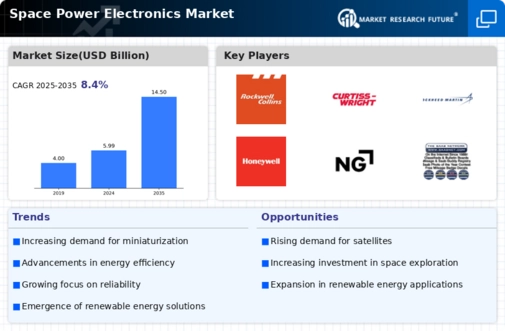Rise of Satellite Constellations
The proliferation of satellite constellations is a key driver for the Space Power Electronics Market. Companies like SpaceX and OneWeb are launching thousands of small satellites to provide global internet coverage, which requires sophisticated power electronics for operation. These satellites demand lightweight, efficient, and durable power systems to ensure longevity and performance in harsh space environments. The market for satellite power systems is expected to reach USD 1.5 billion by 2026, reflecting the increasing reliance on satellite technology for communication and data services. As more constellations are deployed, the need for innovative power solutions will likely escalate, further stimulating growth in the Space Power Electronics Market.
Emergence of Electric Propulsion Systems
The emergence of electric propulsion systems is transforming the Space Power Electronics Market. These systems, which utilize electric or magnetic fields to propel spacecraft, require advanced power electronics to manage energy efficiently. The increasing focus on reducing launch costs and enhancing mission capabilities has led to a growing interest in electric propulsion technologies. For example, the European Space Agency's BepiColombo mission to Mercury employs electric propulsion, showcasing the potential of these systems. The market for electric propulsion is anticipated to grow significantly, with estimates suggesting a value of USD 3 billion by 2027. This trend indicates a shift towards more sustainable and efficient space travel, thereby driving the Space Power Electronics Market.
Growing Investment in Space Infrastructure
Growing investment in space infrastructure is a significant driver for the Space Power Electronics Market. Governments and private companies are increasingly funding projects aimed at enhancing space capabilities, including satellite launches, space stations, and lunar bases. For instance, the United States has proposed substantial funding for the development of lunar infrastructure as part of its Artemis program. This investment necessitates advanced power electronics to support various systems, from life support to communication. The market is expected to benefit from this influx of capital, with projections indicating a growth rate of 9% over the next five years. As infrastructure expands, the demand for reliable and efficient power systems will likely increase, thereby bolstering the Space Power Electronics Market.
Advancements in Space Exploration Technologies
The Space Power Electronics Market is experiencing a surge in demand due to advancements in space exploration technologies. As nations and private entities invest heavily in missions to Mars, the Moon, and beyond, the need for reliable power systems becomes paramount. For instance, NASA's Artemis program aims to return humans to the Moon by 2024, necessitating robust power electronics for lunar habitats and rovers. The market is projected to grow at a compound annual growth rate of approximately 8% over the next five years, driven by these ambitious exploration goals. Furthermore, the integration of advanced power management systems is likely to enhance the efficiency and reliability of power distribution in spacecraft, thereby propelling the Space Power Electronics Market forward.
Increased Demand for Renewable Energy Solutions
The Space Power Electronics Market is witnessing increased demand for renewable energy solutions, particularly solar power systems. As space missions aim for sustainability, the integration of solar panels and energy storage systems is becoming essential. Solar power provides a reliable energy source for satellites and space stations, reducing dependency on traditional fuel sources. The International Space Station, for instance, relies heavily on solar energy, which underscores the importance of efficient power electronics in managing energy flow. The market for solar power electronics in space applications is projected to grow at a rate of 7% annually, driven by the need for sustainable energy solutions. This trend not only supports mission objectives but also aligns with broader environmental goals, further propelling the Space Power Electronics Market.

















Leave a Comment